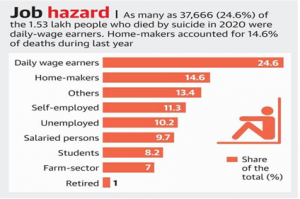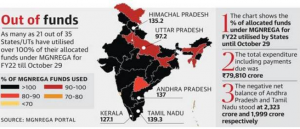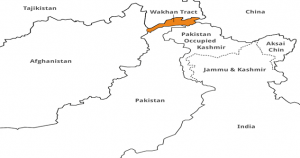INDIAN POLITY, GOVERNANCE AND SOCIAL JUSTICE
1. SUICIDES AMONG FARMWORKERS ROSE 18% IN 2020
THE CONTEXT: According to the National Crime Records Bureau (NCRB) report, the number of agricultural labourers who died by suicide in 2020 was 18% higher than the previous year.
THE EXPLANATION:
- Suicides among landowning farmers dropped slightly during the pandemic year.
- Landless agricultural labourers, who did not benefit from income support schemes such as PM Kisan, may have faced higher levels of distress during the pandemic.
- The worst among the States continues to be Maharashtra, with 4,006 suicides in the farm sector, including a 15% increase in farmworker suicides.
- The other States with a poor record include Karnataka (2016), Andhra Pradesh (889) and Madhya Pradesh (735).

SOURCE: TH
2. A NATIONWIDE EXPANSION OF PCV
THE CONTEXT: Union Health Minister launched a nationwide expansion of Pneumococcal 13-valent Conjugate Vaccine (PCV) under the Universal Immunisation Programme (UIP) as a part of ‘Azadi ka Amrit Mahotsav’.
THE EXPLANATION:
- It was for the first time in the country that PCV would be available for universal use. Pneumonia was a leading cause of death among children under five, globally and in India.
- Pneumonia caused by pneumococcus is the most common cause of severe pneumonia in children.
- Around 16% of deaths in children occur due to pneumonia in India. The nationwide roll-out of PCV will reduce child mortality by around 60%
ABOUT PCV13
- Pneumococcal conjugate vaccine (PCV13) protects against bacterial infections that can cause life-threatening meningitis, pneumonia or sepsis.
- Pneumococcal disease refers to any illness caused by pneumococcal bacteria. These bacteria can cause many types of illnesses, including pneumonia, which is an infection of the lungs.
- Besides pneumonia, pneumococcal bacteria can also cause Ear infections, Sinus infections, Meningitis (infection of the tissue covering the brain and spinal cord), Bacteremia (infection of the blood).
- Side effects: Redness, swelling, pain, or tenderness where the shot is given, and fever, loss of appetite, fussiness (irritability), feeling tired, headache, and chills can happen after PCV13 vaccination.
- India’s first pneumococcal conjugate vaccine (PCV) named “Pneumosil” was launched in 2020. It has been developed by the Serum Institute of India Private Limited (SII) in collaboration with partners like the Bill and Melinda Gates Foundation.
- A conjugate vaccine is a type of vaccine which combines a weak antigen with a strong antigen as a carrier so that the immune system has a stronger response to the weak antigen.
SOURCE: TH
3. INDIA’S R VALUE STEADY AT 0.90
THE CONTEXT: India’s effective reproduction number or R for Covid is steady at 0.90, the same as last week. However, several states including West Bengal, Assam and Himachal Pradesh are now showing an upward trend in infections.
THE EXPLANATION:
- R indicates the average number of people who are likely to catch the infection from a Covid positive individual. The value of R should remain below 1 for the pandemic to come to an end.
- Himachal Pradesh now has the highest R at 1.20. R for West Bengal and Telangana too is above 1.
- R values for Maharashtra and Karnataka are 0.94 and 0.95, respectively.
- Kerala is once again witnessing a rise in infection rate(0.89). While for Tamil Nadu, the value reduced from 0.94 to 0.92, Odisha’s R dropped from 0.90 to 0.88 this week.
- Among cities, Kolkata has the highest R of 1.14, followed by Delhi, which has R at 1.1.
- R for Bengaluru and Chennai is 0.93 and 0.92, respectively. Meanwhile, Mumbai’s R is at 0.94, and Pune’s R is relatively low at 0.84.
SOURCE: THEPRINT
4. PUBLIC AFFAIRS INDEX 2021
THE CONTEXT: Kerala, Tamil Nadu and Telangana have taken the top three slots, emerging winners among the 18 large states in governance performance, Public Affairs Centre (PAC), a Bengaluru-based nonprofit think tank.
EXPLANATION:
- Gujarat ranks fifth, Karnataka seventh and Maharashtra 12th in the ranking.
- A highlight of this year’s study is the Covid-19 response index. It is an analysis of the government response of the states to the pandemic and the degree of success achieved in mitigating its impact.
- While Sikkim, Goa and Mizoram have emerged winners among the small states, Puducherry, Jammu & Kashmir and Chandigarh are the toppers among the union territories.
- In the overall rankings, Kerala continues to be at the top and Tamil Nadu has retained its second place. Telangana has replaced Andhra Pradesh at the third spot compared to last year’s ranking.
- The study shows Telangana, Jharkhand and Chhattisgarh have performed better than their parent States.
- Telangana, Chhattisgarh, Jharkhand and Gujarat have performed well in the overall index, while Maharashtra, Assam, Karnataka and Andhra Pradesh have slipped in rankings as compared to last year, the study noted.
- Andhra Pradesh which ranked third last year ranks eighth this time due to its fall in the equity and growth pillars. Similarly, Karnataka which ranked fourth last time has declined to seventh place — it has slipped from 12th place to 16th place on the equity pillar score.
- Gujarat which ranked ninth last year has climbed to fifth position this year. While West Bengal which ranked 12th last year, has slipped to 15th, Maharashtra that ranked seventh last year has slipped to 12th because of a drastic fall in the equity pillar.
- This is a clear indication that Maharashtra is struggling to recover from the pandemic, the study has noted.
- A surprise feature is Jharkhand’s jump from 15th to 9th place and ranking third in the growth pillar.
About PAI
- Public Affairs Index (PAI 2021), as the study is called, has prepared the list based on scores secured by the states in governance performance across the pillars of equity, growth and sustainability.
- The study is an annual assessment of the adequacy and quality of governance in states, and it has also assessed the states on the basis of their implementation of the centrally sponsored-programmes of rural employment guarantee scheme, national health mission, integrated child development service, Samagra Siksha Abhiyan and mid-day meal scheme.
- The Public Affairs index series is a purely evidence-based assessment of the performance of states using only the central government data sources.
SOURCE: ET
ENVIRONMENT, GEOGRAPHY AND AGRICULTURE
5. HEALTH INSURANCE FOR INDIA’S MISSING MIDDLE
THE CONTEXT: NITI Aayog released a comprehensive report titled Health Insurance for India’s Missing Middle, which brings out the gaps in the health insurance coverage across the Indian population and offers solutions to address the situation.
THE EXPLANATION:
- The report highlights the need for designing a low-cost comprehensive health insurance product for the missing middle.
- It primarily recognizes the policy issue of low financial protection for health for the missing middle segment and highlights health insurance as a potential pathway in addressing that.
- In doing so, the report offers a starting point for broader discussions on solutions, and specific products, to improve insurance coverage for the missing middle.
- The report proposes wider industry and government stakeholder consultations, and discussion with consumer groups to delve deeper into the specifics of the problem, and potential solutions.
SOURCE: PIB
INDIAN ECONOMY
6. AYUSH MARKET SIZE CROSSES US DOLLARS 18 BILLION
THE CONTEXT: Buoyed by the growing global and domestic demand and enabled by strong support to regulatory, research and development, and back-end infrastructure by the Ministry, the market size of AYUSH has grown by 17 per cent in 2014-20 to reach US dollars 18.1 billion.
THE EXPLANATION:
- As per the Research and Information System for Developing Countries (RIS) report, despite a slump in economic activity in 2020 due to the pandemic, the industry is projected to reach US$ 20.6 billion in 2021 and US$ 23.3 billion in 2022.
- In terms of the global share, India has grown faster in the AYUSH market as compared to the world and accounts for about 2.8 per cent of the market, which is likely to hold even though disruptions in production are not ruled out.
- During the same period, different product segments have grown at a much higher rate than the overall industry.
- Plant derivatives experienced 21 per cent growth in the period 2014-2020 followed by nutraceuticals (20.5 per cent), pharmaceuticals (15.8 per cent), plant extracts 14.7 per cent and herbal plants (14.3 per cent).
- Ayush medicines have done exceedingly well in helping Covid19 patients recover faster across the world during the first and second waves of pandemics in the last one and a half years.
SOURCE: PIB
7. NO MONEY LEFT IN MGNREGA COFFERS
THE CONTEXT: The Centre’s flagship rural employment scheme has run out of funds halfway through the financial year, and supplementary budgetary allocations will not come to the rescue for at least another month when the next Parliamentary session begins.
THE EXPLANATION:
- According to its own financial statement, the Mahatma Gandhi National Rural Employment Guarantee Act (MGNREGA) scheme shows a negative net balance of Rs 8,686 crore.

- This means that payments for MGNREGA workers as well as material costs will be delayed unless the States dip into their own funds.
- Activists say the Centre is condemning workers to “forced labour” by delaying wage payments at a time of economic distress.
- However, the Centre is now accusing many States of “artificially creating demand” for work on the ground.
- During last year’s COVID-19 lockdown, the scheme was ultimately given its highest budget of Rs 1.11 lakh crore.
SOURCE: TH
8. SHAKTIKANTA DAS GIVEN 3-YEAR EXTENSION AS RBI GOVERNOR
THE CONTEXT: The Government of India has extended the tenure of Reserve Bank of India (RBI) governor Shaktikanta Das for a period of three years.
THE EXPLANATION:
- Mr Das was appointed as RBI’s 25th governor on December 11, 2018, for a period of three years, after the then governor Urjit Patel resigned before the end of his term.
- Prior to that, Mr Das had served as Revenue Secretary and Economic Affairs Secretary in the Ministry of Finance.
- With the extension, he will head the RBI till December 2024.
- Das, 1980 batch officer, played an important role in steering the economy during the COVID-19 period.
- Under his leadership, RBI announced more than 100 measures to maintain financial stability and push growth during the unprecedented crisis.
- To steer the economy out of the woods, triggered by a once-in-a-century pandemic, he took both conventional and unconventional measures.
- The Monetary Policy Committee (MPC) headed by him brought down the benchmark interest rate to a record low of 4 per cent last year in May, and since then it has maintained an accommodative stance to support the economy. The government’s largest-ever borrowing of Rs 12.60 lakh crore was also conducted smoothly.
- In his earlier stint as Economic Affairs Secretary from 2015 to 2017, Das worked closely with the central bank and oversaw the demonetisation of high-value notes in late 2016.
- After his retirement, he has named India’s G-20 sherpa and was also appointed as a member of the 15th Finance Commission.
SOURCE: TH
INTERNATIONAL RELATIONS
9. PM MEETS ITALIAN PM MARIO DRAGHI
THE CONTEXT: PM met the Prime Minister of Italy, H.E. Mr Mario Draghi in Italy on 29 October 2021, on the sidelines of the G20 Summit in Rome. This was their first in-person meeting.
THE EXPLANATION:
- PM congratulated Prime Minister Draghi for successfully hosting the G20 in the midst of a global pandemic. Italy is also partnering with the UK in organizing COP-26 in Glasgow.
- The two leaders discussed the challenges posed by climate change, and the need for the international community to work together.
- PM highlighted the transformative climate actions undertaken by India and the concerns of developing countries about climate financing commitments of the developed world.
- The two leaders also exchanged views on recent global and regional developments, including in Afghanistan and the Indo-Pacific. They reiterated their desire for working closely together to further the India-EU multi-faceted cooperation.
- On the bilateral side, the two leaders reviewed developments since the India-Italy Virtual Summit in November 2020 and expressed satisfaction at the progress in implementation of the 2020-2025 Action Plan adopted at the Virtual Summit that set strategic goals in the political, economic, S&T and cultural spheres to be achieved in the next five years.
- The two leaders reiterated their commitment to further expanding trade and investment linkages between the two countries particularly in textiles, food processing, automotive and renewable energy sectors.
- To provide fresh impetus to the bilateral cooperation in renewables and clean energy, India and Italy issued a Joint Statement announcing a Strategic Partnership on Energy Transition and agreed to explore partnerships in areas such as large size green corridor projects, smart grids, energy storage solutions, gas transportation, integrated waste management (waste-to-wealth), development and deployment of green hydrogen and promotion of biofuels. India and Italy also signed a Statement of Intent on Textiles cooperation during the meeting.
- PM extended an invitation to PM Draghi to pay an official visit to India at the earliest opportunity.
SOURCE: PIB
10. UNGA COMMITTEE ENDORSES INDIA’S RESOLUTION FOR GRANTING OBSERVER STATUS TO ISA
THE CONTEXT: A draft resolution introduced by India for granting the Observer Status to the International Solar Alliance has been adopted in a U.N. General Assembly committee.
THE EXPLANATION:
- The draft resolution was adopted in the General Assembly’s Sixth Committee, which deals with legal issues, without a vote on October 28.
- The 76th session of the UN General Assembly will now have to formally adopt the recommendation of the Sixth Committee.
- The General Assembly decided that observer status would be confined to states and intergovernmental organisations whose activities cover matters of interest to the Assembly.
- The Sixth Committee of the General Assembly considers all applications for observer status before they are considered in the plenary session. Permanent Observers may participate in the sessions and workings of the General Assembly and maintain missions at the UN Headquarters.
- Intergovernmental organisations having received a standing invitation to participate as Observers in the sessions and the work of the General Assembly include the EU, INTERPOL, International Renewable Energy Agency, OECD, ADB, ASEAN, Commonwealth of Independent States, European Organisation for Nuclear Research, Indian Ocean Rim Association, SCO, SAARC, International Committee of the Red Cross and International Olympic Committee.
- The International Solar Alliance was opened for signature as an international treaty-based organisation in November 2016 and the agreement entered into force on December 6, 2017.
- The alliance of solar-resource rich countries with its membership was open to those 121 U.N. member states that lie fully or partially between the Tropics of Cancer and Capricorn.
- This was further amended at the First Assembly of the ISA, to expand the scope of ISA membership to all U.N. member states.
SOURCE: TH
PRELIMS PRACTICE QUESTIONS
Q1 A conjugate vaccine is:
a) A single vaccine is used for two different diseases.
b) A vaccine is used for a single disease.
c) A vaccine that combines a weak antigen with a strong antigen as a carrier.
d) A vaccine that combines a strong antigen with a weak antigen as a carrier.
ANSWER FOR OCTOBER 29, 2021 PRELIMS PRACTICE QUESTIONS
Q1 Answer: C
Explanation:
- It is a narrow strip of territory in Afghanistan, extending to China and separating Tajikistan from Pakistan.
- From this high mountain valley, the Panj and Pamir rivers emerge and form the Amu Darya.
- The corridor was formed by an 1893 agreement between the British Empire (British India) and Afghanistan, creating the Durand Line.
- This narrow strip acted as a buffer zone between the Russian Empire and the British Empire.





